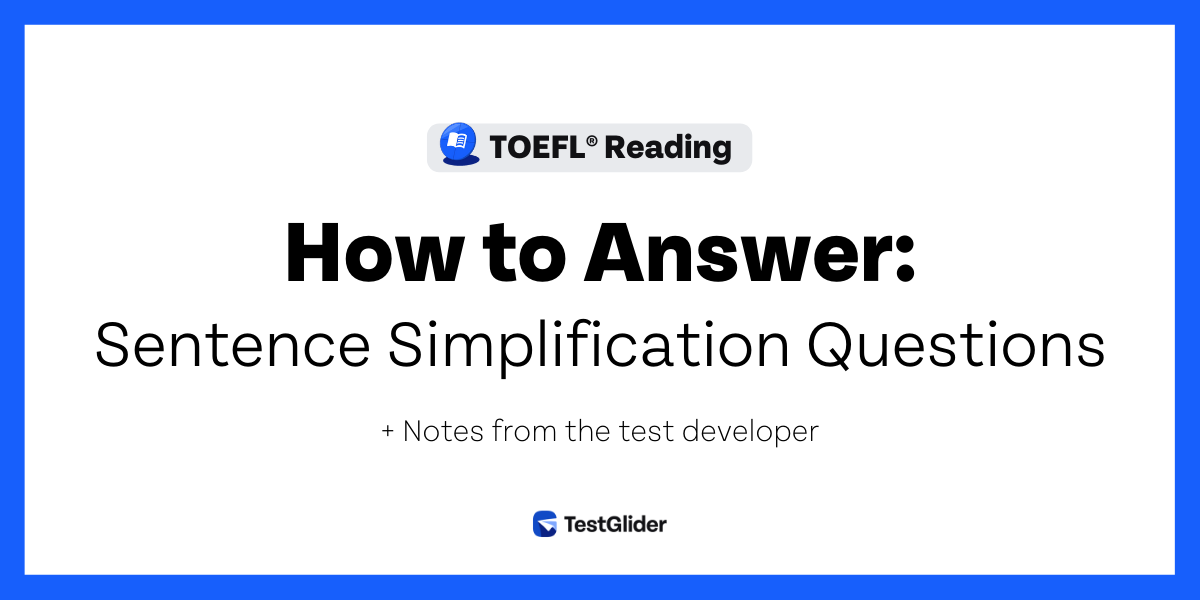1. Information about Sentence Simplification/Essential Information Questions
TOEFL Reading Sentence Simplification questions ask the test taker to identify a sentence that has the same essential meaning as a sentence selected from the reading passage.
The correct answer choice will contain the same main ideas as the sentence in the passage, but less important or minor details may be omitted. It should also restate the main ideas in a simpler way than the sentence in the passage.
The distractors will contain actual ideas and details from the sentence, but they will omit important ideas, distort an idea or concept, or they may even change the meaning of the entire sentence.
These questions are very easy to spot because they will refer to an entire highlighted sentence in the passage. They are also always written in the same way:
-
- Which of the sentences below best expresses the essential information in the following sentence? Incorrect choices change the meaning in important ways or leave out essential information.
- Which of the sentences below best expresses the essential information in the following sentence? Incorrect choices change the meaning in important ways or leave out essential information.
2. TOEFL Reading Sentence Simplification Question Example
Here is an excerpt from a passage and its Sentence Simplification question:
“In October 1920, Canadian surgeon Frederick Banting read an article that stated that the Islets of Langerhans deteriorated at a slower rate than the rest of the pancreatic cells. He hypothesized that insulin might be removed from the pancreas by isolating and separating those cells from the rest of the organ. Banting had no way to test his theory, so he turned to University of Toronto professor John Macleod. Convinced that the idea was worth testing, Macleod provided laboratories and recruited research student Charles Best, who specialized in testing blood glucose levels. They restricted the pancreatic duct in a dog in a way that allowed the islets to remain healthy, and extracted insulin from the cells. They injected the extract into a dog with no pancreas, and its blood sugar levels were reduced.”
Q. Which of the sentences below best expresses the essential information in the highlighted (bolded) sentence in the passage? Incorrect choices change the meaning in important ways or leave out essential information.
(A) John Macleod did not think that Banting’s idea had merit, so he only provided him with work space and a research student.
(B) Macleod thought that Banting might be correct, so he agreed to work with him and brought in a student who was skilled at blood testing.
(C) Banting’s hypothesis impressed Macleod, who decided to test the idea himself with a student and excluded Banting from the study.
(D) Certain that he was correct, Banting rented research laboratories from the University of Toronto, which provided John Macleod and Charles Best to assist him.
Answer Explanation
(B) is the correct answer. All of the correct important information is included in this sentence. Macleod thought that Banting’s idea was worth testing, so he arranged facilities and skilled staff to perform the study.
-
-
- Choice (A) is incorrect because it says that Macleod thought Banting’s idea “did not … have merit.”
- Choice (C) is incorrect because it says that Macleod “excluded Banting from the study,” but that is not indicated in the original sentence.
- Choice (D) is incorrect because it changes and adds details. Banting contacted Macleod directly and not the university.
-
3. Notes from the Test Developer
Every passage in the TOEFL reading section has one Sentence Simplification question. These questions ask only about information that is included within a single sentence from the passage. All of the answer choices have to include some of the main ideas that are contained within the sentence or they will be obviously false, but one contains all of the main ideas and important details.
In the above example, the correct answer omits the student’s name, because that is not as important as the fact that he is skilled at blood testing. As a writer these questions are difficult to create, because they all need to seem accurate at first glance. I have to include small but important deviations from the original sentence. They may omit important information, focus on minor details, incorrectly state information, or include details that are not in the original sentence at all. Some also include a combination of these paraphrasing errors. They should also use clearer, less complex language than the original sentence, which can be difficult to achieve.
That is why I tend to choose very long sentences to make these questions. The example sentence is 23 words, which is actually a little short. Typically they will be 25 to 40 words long because that allows for more main and minor details to be included.
4. Advice to Test Takers
I would advise test takers to do a few things when they need to solve a Sentence Simplification question. First, keep in mind that you are being asked to focus on only one sentence. Information that exists outside of that sentence should not be included in the correct answer.
Second, all of the answer choices may contain correct details from the sentence, but the distractors will present that information incorrectly, or add or remove important ideas. You should read the passage and each answer choice carefully to see whether they contain all of the main ideas or if they change or omit details.
Finally, you have limited time, and all of the distractors will contain some correct information, so you may be unable to decide between two answer choices. In that case, guess. Remember that you do not get points deducted for wrong answers in TOEFL. This is true for all questions so if you don’t know the answer or if you don’t have time to actually solve the question, guess.
